Artist Interview
関西から東京へ。
共通の技法を用いて、それぞれの情景を表現する新進気鋭の若き二人のアーティスト。
勝木有香さんと佐藤雄飛さん。
先立って京都で展示会が行われ、ついに東京でも10月20日よりno-maにて二人の合同作品展「目眩」が開催されます。
今回は、今まで取り上げてきたアート作品よりアカデミックな印象なので、ハードルが高いと思われるかもしれませんが、自分を含めアートに対して初心者と感じている方も、この記事を読んでいただいて、作品を鑑賞する際のヒントにしていただければ幸いです。
また上級者の方も改めて自分の視点とアーティストの視点を照らし合わせる深堀りする機会になれば嬉しいです。それでは、どうぞ!!
From Kansai to Tokyo.
Two up-and-coming young artists who use a common technique to express their respective scenes.
Yuka Katsuki and Yuhi Sato.
An exhibition was held in Kyoto earlier, and finally in Tokyo, a joint exhibition of their works, “MEMAI (meaning Dizzy)”, will be held at no-ma from October 20. This exhibition is more academic than the previous ones I’ve introduced, so you may think it’s a bit of a hurdle, but I hope this article will give you a hint on how to appreciate art, even if you feel like a beginner.
For those who are familiar with art, I hope this will be an opportunity for you to dig deeper and compare your own perspective with that of the artists. So, here you go!
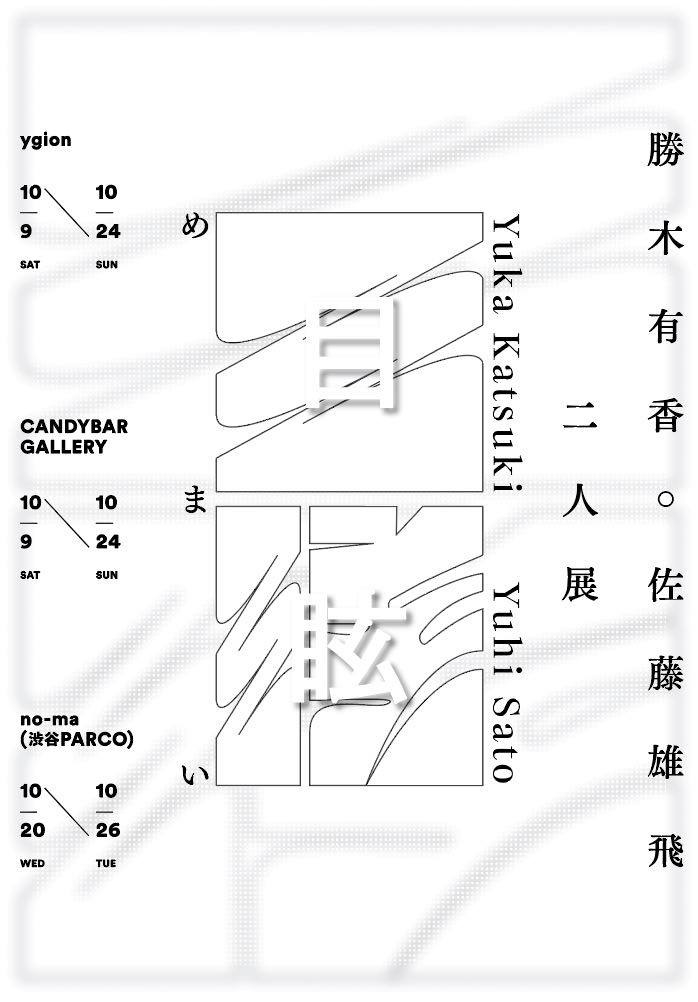
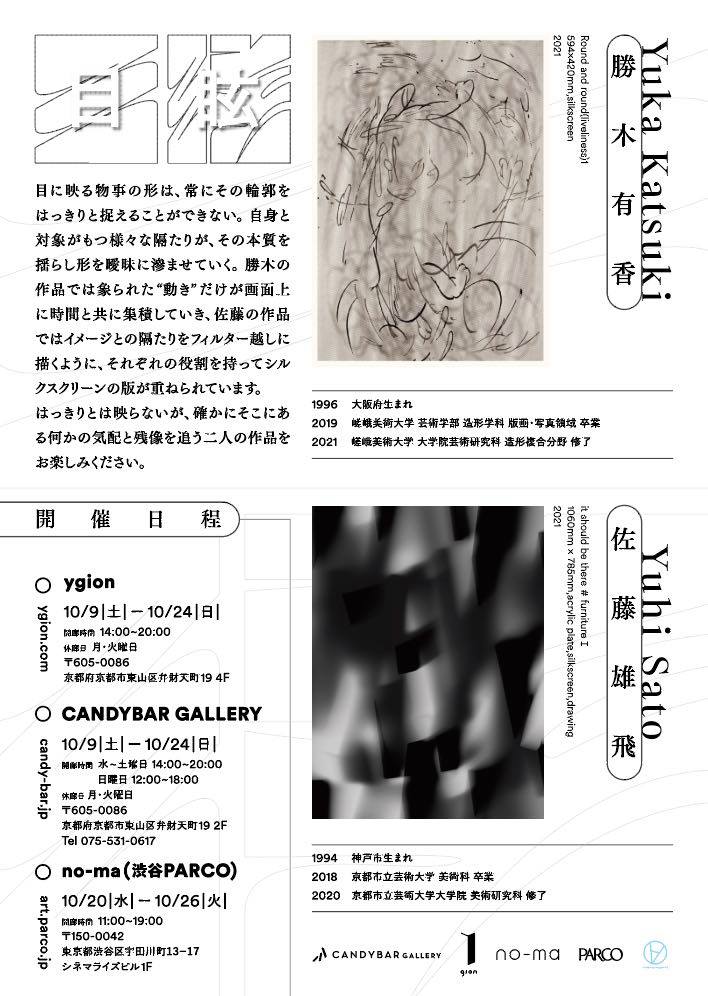
・開催期間 :2021年10月20日(水)- 10月26日(火)
・営業時間 :11:00-19:00
・場所 :「no-ma」at 渋谷PARCO
・住所 :東京都渋谷区宇田川町13-17 ライズビル1階
Period: October 20, 2021 (Wednesday) – October 26, 2021 (Tuesday)
Opening hours: 11:00 – 19:00
Location: “no-ma” at Shibuya PARCO
Address: Rise Building 1F, 13-17 Udagawa-cho, Shibuya-ku, Tokyo
-今日はよろしくお願いします。
早速ですが、お二人がご一緒に展示会をやることになった経緯をお聞きして良いですか?
佐藤:大学の制作展で作品をギャラリストの方に見ていただいて、その方に勝木さんと、ご一緒に展示してみないかと勧められたのが最初です。
-Thank you for your time today.
First of all, may I ask how you two decided to have an exhibition together?
Sato: A gallerist saw my work at a university exhibition, and he suggested that I exhibit with Mr. Katsuki.
–元々は知り合いではなかったのですね。
佐藤:知り合いではなかったのですが、各京都の美大が一堂に介する、版画専攻の合同発表会がありまして、そこで各々発表していたので勝木さんの顔と作品は知っていました。
-So you didn’t know each other in the beginning.
Sato: We didn’t know each other, but there was a group exhibition of print art majors where all the art universities in Kyoto came together, and I knew Katsuki’s face and her works because she had presented there.
−美大ならではの横の繋がりですね。勝木さんも佐藤さんのことはご存知でしたか?
勝木:私は、その時はまだ全然知らなくて…(笑)
でも佐藤さんの作品は、修了制作展の時に見る機会があって、すごく「カッコいい作品だな」と感じていました。そういう経緯もあったので、一緒に展示すると決まった時は嬉しかったですね。
-It’s a horizontal connection that only art universities can provide. Did you know Mr. Sato as well, Ms. Katsuki?
Katsuki: I didn’t know anything about him at that time…lol
But I had a chance to see Mr. Sato’s work at the graduation project exhibition, and I thought it was really cool. So I was happy when it was decided that we would exhibit together.
−「かっこいい」と感じたとのことですが、具体的にどのような部分で?
勝木:私と同じシルクスクリーンという技法で制作していて、佐藤さんが作る静かな空間がかっこいいなと。私は壁に貼って展示をするのですが作品を自立させるという佐藤さんの方法は、自分の中で新たな発見でした。
佐藤:ぼくが勝木さんの作品に感じた印象はドローイングがストリート寄りというか。雰囲気がかっこいいと感じていました。一方で物の形が不気味に変形するような、シュルレアリズムの文脈のような奥深さみたいのを感じていました。
-You said you found it “cool”, but in what specific parts?
Katsuki: He uses the same silkscreen technique as I do, and I thought the quiet space he created was cool. His method of letting the works stand on their own was a new discovery for me, while I usually exhibit my works on the wall.
Sato: My impression of her works was that her drawings were more street-oriented. I thought the atmosphere was cool. On the other hand, I felt that the shapes of objects were eerily deformed, and there was a sense of depth in the context of Surrealism.
※シルクスクリーン…シルクスクリーンは印刷の一種で、メッシュ状の版に孔を作り、孔の部分にだけインクを落として印刷する印刷方法。アパレルTシャツなどもこの方法が採用される場合が多い。
※ドローイング…線で構成された絵。つまり線画表現のこと。
※シュルレアリスム…1920年頃(諸説によってさまざま)に起きた文学・芸術運動。意識下の世界などが描かれるのが特徴。お笑いで使われるシュールという表現もここから来ている。
※Silk screen: Silk screen is a type of printing in which holes are made in a mesh-like plate and ink is dropped only on the holes. In many cases, this method is used for apparel T-shirts.
※Drawing: A picture composed of lines. In other words, a line drawing expression.
※Surrealism: A literary and artistic movement that took place around 1920 (depending on the theory). It is characterized by the depiction of the subconscious world. The expression “surrealism” used in Japanese comedy also comes from here.
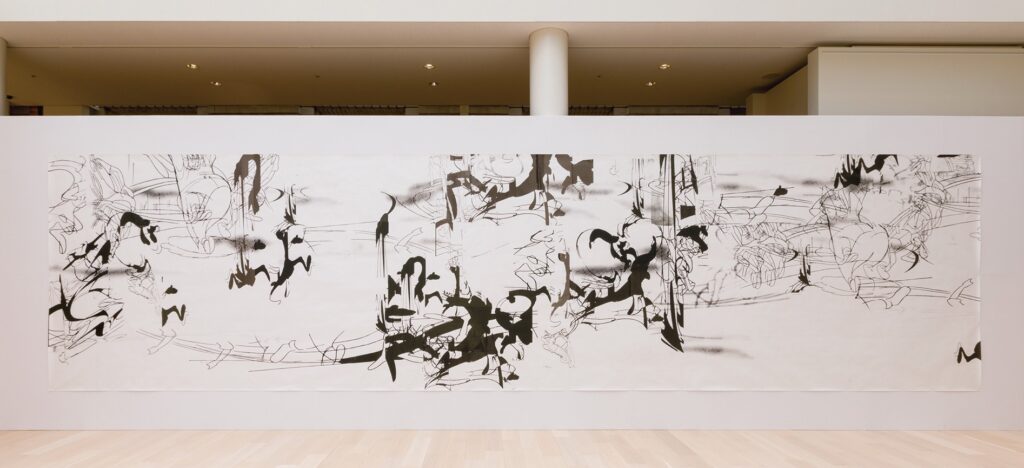
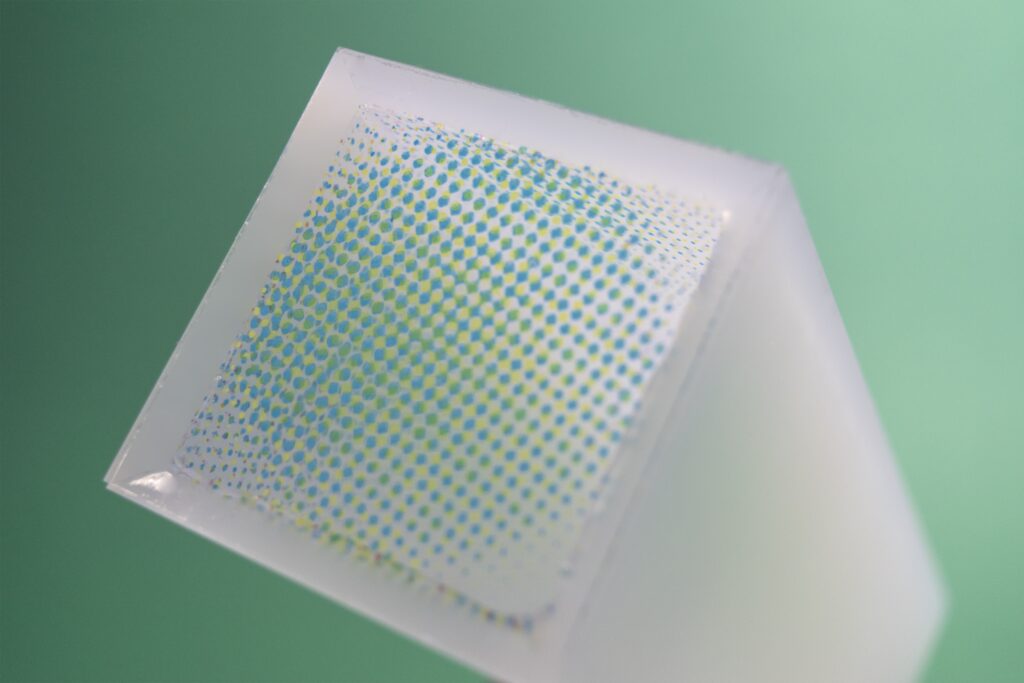
−なるほどですね。シュールレアリズムというキーワードが出てきましたが、お二人の作品はその流れにある抽象表現の領域なのでしょうか?
勝木:私の中で抽象は、感情とか形にできないものを色とかで表現するものだと思っていて、自分の作品は違うのかなと思っています。
抽象になりつつある部分もあるのかもしれませんが、具象と抽象を行き来する、形になるかならないか、目に見えるけど見えない…などの境界線を狙っているので、”抽象””具象”みたいにハッキリさせて描いてはいないですね。
佐藤:ぼくも抽象ではないですね。モチーフがあるので。
-I see. The keyword “surrealism” came up, but is your work in the domain of abstract expression in that style?
Katsuki : In my mind, abstraction is about expressing emotions and other things that cannot be put into form through color and other means, and I think my work is different.
There may be a part of my work that is becoming more abstract, but I aim to draw a boundary between figurative and abstract, between form and formlessness, visible and invisible. So I don’t paint clearly as “abstract” or “concrete”.
Sato: It’s not abstract for me either, because I have a motif.
−どのようなものをモチーフにしているのですか?
佐藤:はい。磨りガラスをモチーフにしています。子供の頃、外で民家の磨りガラスの部屋の中にある家具や、人の影が映っていたのを見て、「どういう部屋なのだろう?」「どういう人が住んでいるだろう?」みたいに想像していたことを憶えていました。
色々な作風の作品を試行錯誤しながら制作しているなかで、その体験を思い出し、「鮮明じゃないものを想像することって面白いのでは?」と思いつき、作品に昇華しようと思ったのがきっかけだと思います。
勝木:私は、電車の車窓から見える建物や景色、揺れるカーテンなど身近にあるものから、他ジャンルの作品、コンテンポラリーダンスの動きなど、頭の中の動きのイメージみたいなものが残っていて、シルクスクリーンというイメージを重ねる技法を使うことで、静止しているけど、まるで動いているような、動いているその流れを一つの画面に収めることができるのではないか?と考えたことがキッカケですね。
-What are the motifs?
Sato: I used frosted glass as a motif. When I was a child, I saw the reflection of furniture and people’s shadows in the frosted glass of a private house, and I often imagined, “What kind of room is this?” “What kind of people live there?”
As I was creating works in various styles through trial and error, I remembered the experience and thought, “Isn’t it interesting to imagine something that is not vivid?” I came up with this idea and decided to sublimate it into a work of art.
Katsuki: My inspiration came from familiar things such as buildings and scenery seen from train windows and swaying curtains, as well as works of other genres and contemporary dance movements, which left me with a kind of image of movement in my mind. I thought that by using the silkscreen technique of layering images, it would be possible to capture the flow of movement on a single screen, as if it were moving even though it was still.
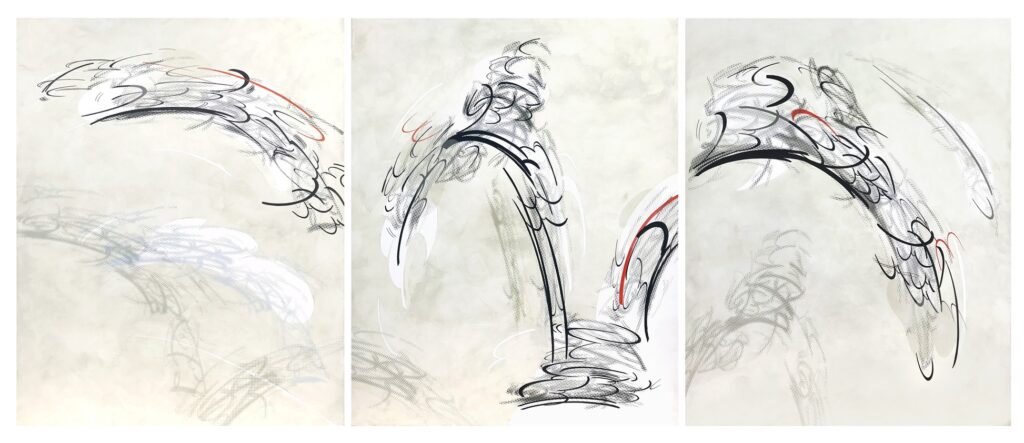
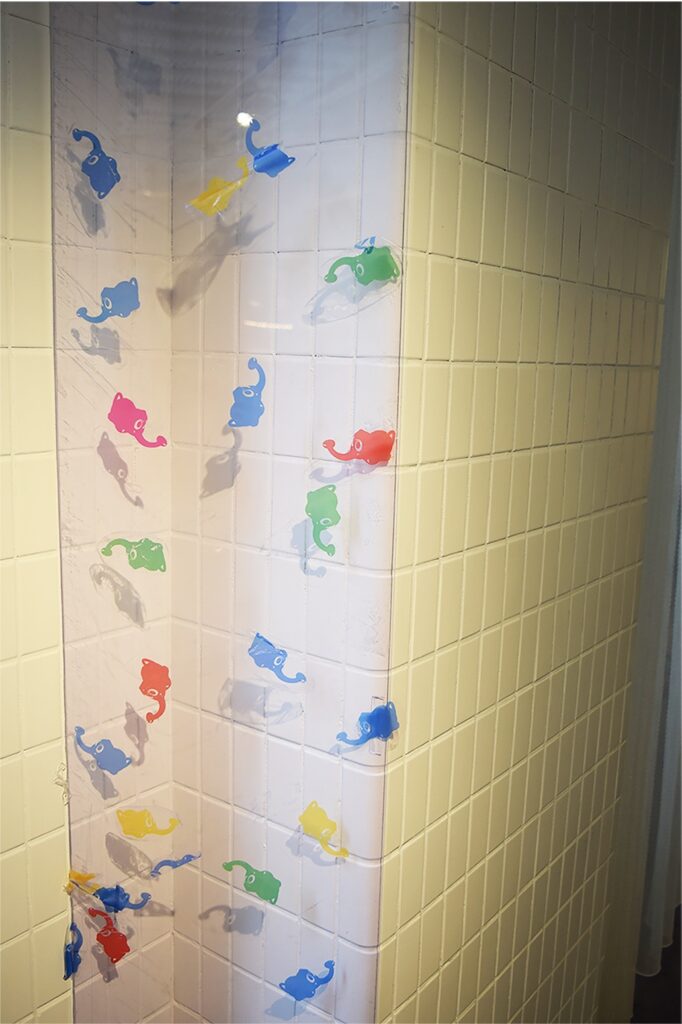
上から勝木さん、佐藤さんのスタイルが確立される前の作品。あくまで個人的な主観だが勝木さんの作品は既に現在のスタイルに到達しているような気も。一方で佐藤さんの作品は模索をしてるのがどこか伝わってくる作風。
From the top, works by Ms. Katsuki and Mr. Sato before their styles were established. It’s just my personal opinion, but I feel that Ms. Katsuki’s work has already reached her current style. On the other hand, Mr. Sato’s works show that he is still searching for a new style.
−はじめから、そのようなモチーフだったのでしょうか?
勝木:自分が興味のあるものから探っていったのですが、静物画を描くことよりも抽象画の方が自分自身素直になれて、もっと自由に描けて、ストレスとかも発散できるなと(笑)
最初は動きを軌道的に描いていたのですが、その方法が苦しくなってきてしまって、軌道を描くことプラス「動いている何か」、というモチーフを描いた方が作品のバリエーションが増えるのではと思いました。
そこから色々と試行錯誤し今に至っています。
-Did you have such a motif from the beginning?
Katsuki: I started by exploring my interests, but I found that abstract painting allowed me to be more honest and free than still life painting, and it also allowed me to release stress lol
At first, I drew the movements in the form of orbits, but I began to have trouble with that method, and I thought that drawing orbits plus a motif of “something in motion” would increase the variation in my work.
From there, I went through a lot of experiments and came to here.
−モチーフについては、やはりお二人ともそれぞれなのですね。
お二人が共通するシルクスクリーンという技法に行き着いたキッカケを教えてください。
佐藤:アンディ・ウォーホールですね。マリリン・モンローとか、キャンベルのスープとか、分かりやすいじゃないですか。 大学に入る前から知っていて、そういうことをやりたいなって思っていました。
勝木:高校の時に美術部に入っていて、木版画をやっていました。
大学でも版画をやりたいなと考えていた矢先にシルクスクリーンという技法を知りました。
それこそ佐藤さんが言っていたアンディ・ウォーホールとかのポップな感じとかが好きで、そういえば、小さい頃はお菓子のパッケージや看板とかは良く見ていました。
シルクスクリーンを知った時に自分の好きなことができるかもと可能性を感じました。
シルクスクリーンは他の版種と比べると実は結構簡単にできます。
木版は木を彫る過程が必要ですが、シルクスクリーンはそのまま描いたものが刷れるので。ところが簡単なはずなのに、私はなかなかできなくて(笑)
悔しくてやり続けていたら、自分の中でしっくりくるようになっていました(笑)
あとは自然と作品のテーマとシルクスクリーンのインクの質感から見える軽い印象がリンクしているという流れもあります。
※アンディ・ウォーホール…ポップアートの旗手。これまでの固定観念を覆すようかのような作品の発表だけではなくバンドのプロデュースや映画制作などを手がけた。
-You both have different motifs.
Please tell us how you came to the technique of silk-screening, which you both have in common.
Sato: Andy Warhol. Marilyn Monroe and Campbell’s soup are easy to understand, aren’t they? I knew about him even before I entered university, and I wanted to do something like that.
Katsuki: When I was in high school, I was in the art club and did woodblock prints. Just as I was thinking that I would like to do printmaking in college, I learned about the silk screen technique. I liked the pop style of Andy Warhol and others that Mr. Sato mentioned, and I used to look at candy packages and signboards when I was little. When I learned about silk-screening, I felt the possibility that I could do something I wanted to do.
Silk-screening is actually quite easy to do compared to other types of printing. Woodblock printing requires the process of carving the wood, but silkscreen printing allows you to print what you have drawn. It’s supposed to be easy, but I can’t do it easily lol I was frustrated, so I kept working on it, and it started to feel right to me lol Also, there is a natural link between the theme of the work and the light impression seen from the texture of the silkscreen ink.
※Andy Warhol: A standard-bearer of pop art. Not only has he released works that seem to overturn conventional stereotypes, but he has also produced bands and movies.
−影響を受けている作品やカルチャーなどがあれば教えてください。
佐藤:ウォーホールとかポップアートですね。
あとは雑誌とかは好きで、STUDIO VOICEとかのカルチャー寄り雑誌とかが好きで、そこで特集されているアートとかを見たりしたことによる影響はあるかもしれないですね。
※STUDIO VOICE…カルチャー雑誌。芸術、音楽、映画などのさまざまなカルチャーを特集。現在は休刊中。
勝木:ロイ・リキテンスタインとかの影響はありますね。それ以外だとダンスや音楽など感情を動きやリズムで表現しているものに対し、参考になるというよりかは、伝わるパワーみたいのをもらっている気はします。
もともと小さい頃から舞台とかは好きで見ていましたが、当時はただ好きで見ていただけなのですが、それが記憶に残っていて、今の引き出しになっているのかなと思います。
※ロイ・リキテンスタイン…アンディ・ウォーホールに並ぶポップ・アートの旗手。漫画風の画風、セリフを絵に入れる技法など、こちらも固定観念に囚われない方法論を実践しスタイルを貫いた様は、今日までさまざまなアートに影響を与えている。
-What are some of your influences in terms of work and culture?
Sato: Warhol and pop art.
I also like magazines like STUDIO VOICE, which is more of a culture magazine, and seeing the art featured in those magazines may have influenced me.
※STUDIO VOICE: A culture magazine. Features a variety of culture, including art, music, and film. Currently not published.
Katsuki: I was influenced by Roy Lichtenstein and others. Other than that, in dance and music, where emotions are expressed through movements and rhythms, I feel that I receive power that can be conveyed rather than as a reference.
I have always liked and watched the stage since I was a little girl, but at the time I just liked watching it, but I think it remained in my memory and is what I draw from now.
※Roy Lichtenstein: Along with Andy Warhol, he is a representative of Pop Art. His manga-like drawing style, the technique of inserting dialogues into his pictures, and other methods that defy stereotypes, and the way he carried out his style have influenced various art forms to this day.
−シルクスクリーンという技法では共通していますが、お二人ともポップアートからの影響というのは意外なような気がしました。シルクスクリーンはエディション文化のイメージが強いのですが、お二人の作品もエディションはあるのでしょうか?
佐藤:僕は敢えてエディションはゆるく捉えて作っていますね。
エディションは作って、その上にドローイングを重ねたりしています。
エディションって微妙な概念で、シルクスクリーンは同じものを刷っても掠れ具合とかに違いが出て完全に同じものではないですよね。
勝木:私もあまりこだわっていなくて、データで制作したものを大きい壁に移すみたいな過程になるので1点モノが多いです。
-Although you both use the same technique of silkscreen, I found it surprising that both of you were influenced by pop art. Silkscreen has a strong image of editioned culture, but do you have editions of your works?
Sato: I don’t have a clear idea of what edition I’m working on.
I make editions, and then I make drawings on top of them.
I make editions, and then I make drawings on top of them.
Edition is a very subtle concept, and even if you print the same thing on a silkscreen, there are differences in the way it is grazed and so on, so it’s not exactly the same.
Katsuki: I’m not too picky either. It’s more like a process of transferring data from the data to a large wall, so there are many one-of-a-kind pieces.
−データで制作しているとのことですが、普段の制作はデジタルなのですか?
勝木:元は必ず鉛筆やGペンを使ってドローイングをし、それをスキャンして、フォトショップやイラストレーションなどを使って再構成をしているような形ですね。
-You say you create with data, but is your usual production process digital?
Katsuki: The original is always a drawing using a pencil or G-pen, which is then scanned and reconstructed using Photoshop or illustration.
−なるほど。ちなみにお二人はシルクスクリーンという共通点以外に関西から東京に来たという共通点もありますが、関西と関東のアートにおけるシーンの違いはありましたか?
佐藤:版画で言うと東京は浮世絵などの影響で、木版、銅版が強かったりします。一方でシルクスクリーンとかポップアートの影響が強いのは関西なんです。そういう事情もあり東京はシルクスクリーンの工房が少なかったり、美大にもシルクスクリーンの専攻が少なかったりします。
人口が少ないという意味では、そこにチャンスがあるのかなと考えています。
勝木:私は普段は美大で助手をしているのですが、佐藤さんが言っていたように関東でシルクスクリーンを教える人がいないということで、東京に呼ばれたみたいな経緯もあって、学生を見ているとシルクスクリーンに興味のある人が多い一方で、ワークショップでしか学べないという様な現状もあるので、魅力もあるし表現の幅も広いから、それを伝えていきたいという思いもあります。
-I see. By the way, you two have something in common besides silk screens, you both came to Tokyo from Kansai. Have you noticed any differences in the art scene between Kansai and Kanto?
Sato: In terms of prints, woodblock and copperplate prints are strong in Tokyo due to the influence of ukiyoe prints. On the other hand, the influence of silkscreen and pop art is strong in Kansai. Because of this, there are not many silk screen studios in Tokyo, and there are also not many silk screen majors in art schools.
In the sense that the population is small, I think there is an opportunity there.
Katsuki: I usually work as an assistant at an art college, but as Ms. Sato said, there is no one to teach silkscreen in the Kanto area, so I was invited to Tokyo. Looking at the students, there are many people who are interested in silkscreen, but they can only learn it in workshops. It has a lot of appeal and a wide range of expression, and I want to pass that on to my students.
前段の質問でも投げかけていますが、一目見た時は抽象表現と呼ばれる領域の芸術だと思って拝見をしていました。ただ実際に話を聞いていると実は「具象」ではないのですが、明確に描いている「モノ」があるという話が印象深かったです。
As I mentioned in my question, when I first saw their work, I thought it was art in the realm of abstract expression. However, when I actually talked with them, I was struck by the fact that they actually had a “thing” that they were drawing clearly, rather than a “concrete” image.
確かに話を聞いて見てみるとそこには形があって、自分の見る力って「まだまだだな…」という反省をしつつも、話を聞いたことで作品の見方を教えてもらえたような気がします。
Indeed, when I looked at their works after listening to the talk, I found that there was a form to them, and I was reminded that my ability to see is still not good enough. I feel like I learned how to look at the work by listening to their stories.
これまでTHAT IS GOODで紹介してきたアートはストリート・カルチャーの文脈、つまり先人へのリスペクトをサンプリング的な技法から発生させる産物を感じさせる作品が中心だったので、それに比べて今回のお二人の作品の、内面的な感性や記憶を暗中模索しながら探し出し、適切な技法をロジカルに考え構築していくという過程は、ファイン・アートとストリート・アートって思想だけじゃなくて制作過程も全く違うんだなと、勉強になりました!
The art that has been introduced on THAT IS GOOD so far has been mainly in the context of street culture, that is, works that show respect for predecessors as a product of sampling techniques. In comparison, the process of groping for inner sensibilities and memories in the works of these two artists, and then logically considering and constructing the appropriate techniques, was a great learning experience for me, as I realized that fine art and street art are not only completely different in thought, but also in production process!
後編ではお二人のパーソナルな話から合同展示会ならではのエピソードなどを伺っていきます!
In the second part of this article, we’ll talk about their personal stories and episodes unique to joint exhibitions!
文:THAT IS GOOD編集部 古賀
TEXT : THAT IS GOOD editorial department, Koga